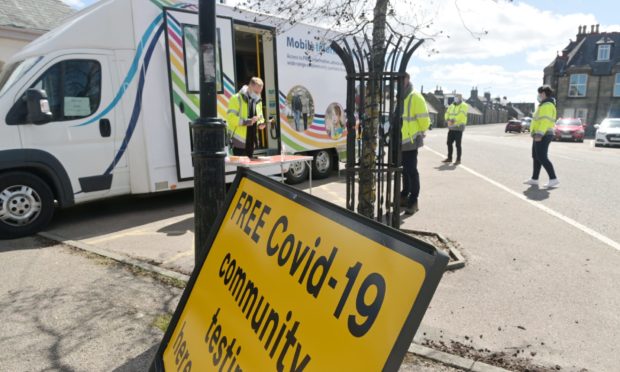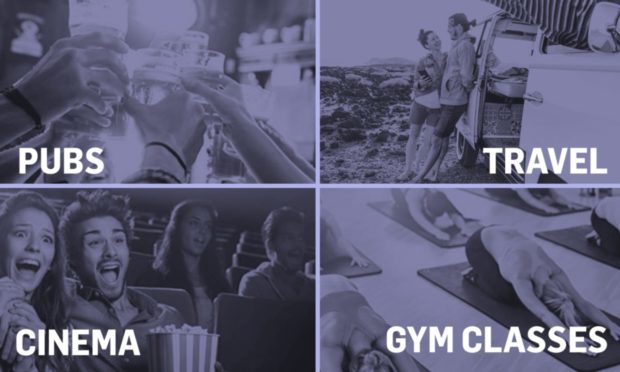Large swathes of Scotland are set to move into a new level of Covid restrictions from Monday.
The vast majority of mainland Scotland, including Aberdeen and Inverness, will move down to level two, allowing more freedoms around mixing with other households, physical distancing and travel, amongst other things.
Many Scottish islands will move to level one of restrictions, allowing more guests at funerals and weddings and stadiums and events to reopen and reboot.
However, Moray and Glasgow will remain in level three for at least another week first minister Nicola Sturgeon announced on Friday.
Here’s everything you need to know about the changes coming into place on Monday, May 17:
What can you do in level two?
- you can meet socially in groups of up to:
- 6 people from 3 households in your home or theirs – and can stay overnight
- 6 people from 3 households in an indoor public place like a café, pub or restaurant
- 8 people from 8 households outdoors
- under 12s do not count towards the total number of people or households meeting outside but do count towards household numbers indoors
- you do not need to physically distance from family and friends in a private home
- you can travel anywhere in Scotland in Levels 0, 1 or 2 but must not enter a Level 3 or 4 area unless for a permitted reason
- you can travel to England, Wales, Northern Ireland, the Isle of Man or the Channel Islands – before you travel you must check the travel rules in those countries
- you can provide informal childcare, for example to look after a grandchild
- up to 50 people can attend weddings and funerals
- tradespeople can carry out any work in your home such as painting, decorating or repairing
- you should work from home where possible
What can open at level two?
Places and business that can open at level two include:
- cafés, pubs and restaurants
- all shops and stores
- all close contact services including hairdressers, barbers and beauty salons
- gyms, leisure centres and swimming pools
- tourist accommodation
- visitor attractions
- public buildings like libraries and community centres
- cinemas, theatres, concert halls, amusement arcades, casinos, bingo halls, bowling alleys and snooker/pool halls
- stadiums and events – with maximum numbers
What must close at level two?
Places and business that must close at Level 2 include:
- soft play, funfairs, nightclubs and adult entertainment
Some areas set to move to level one
From Monday, May 17, Orkney, Shetland, Na h-Eileanan Siar, all islands in Highland (except Skye) and the Argyll and Bute islands of Coll, Colonsay, Erraid, Gometra, Iona, Islay, Jura, Mull, Oronsay, Tiree and Ulva will move to level one. Islands not at level one will move to level two.
What can you do in level one?
- you can meet socially in groups:
- of up to 6 people from 3 households in your home or theirs – and can stay overnight
- of up to 8 people from 3 households in an indoor public place like a café, pub or restaurant
- of up to 12 people from 12 households outdoors in your garden or a public place
- under 12s do not count towards the total number of people or households meeting outside but do count towards the number of households indoors
- you do not need to physically distance from family and friends in a private home
- you can travel anywhere in Scotland in levels 0, one or two but must not enter a level three or four area unless for a permitted reason
- you can travel anywhere in England, Wales, Northern Ireland, the Isle of Man or the Channel Islands – before you travel you must check the travel rules in those countries
- you can provide informal childcare, for example to look after a grandchild
- up to 100 people can attend weddings and funerals
- tradespeople can carry out any work and repairs in your home such as painting, decorating or repairing
- you should work from home where possible
What can open at level one?
Places and business that can open at level one include:
- cafés, pubs and restaurants
- all shops and stores
- all close contact services including hairdressers, barbers and beauty salons
- gyms, leisure centres and swimming pools
- tourist accommodation
- all visitor attractions
- all public buildings like libraries and community centres
- all entertainment (apart from nightclubs and adult entertainment)
- stadiums and events – with maximum numbers
What is the situation in Moray?

Moray will remain under level three of Covid restrictions for at least a further week.
First Minister Nicola Sturgeon confirmed this news in parliament on Friday, with Glasgow also remaining at the same level, as the remainder of mainland Scotland looks forward to restrictions easing from Monday.
Financial help will be offered to businesses in the regions, with £375,000 given to Moray Council to help with this.
Ms Sturgeon said that this was a “difficult” decision but she was “optimistic” that the region could move to level two when the situation is reviewed at the end of next week.
Moray has experienced a surge in Covid cases in recent weeks, with the region’s infection rate hitting more than 100 per 100,000 earlier this week.
Those numbers have fallen slightly, but remain high at 69 per 100,000.
New outbreaks have also been reported in Aberlour and Keith, with mobile testing units being brought in there.
What has Nicola Sturgeon said?
Speaking to Parliament on Friday, Ms Sturgeon announced that Moray and Glasgow would be staying in level three for at least another week.
She said: “In Moray, the latest available data shows that the number of cases per 100,000 is 69 and the test positivity is 1.9%.
“I’m pleased to say that both of these measures are declining and so there are now grounds for cautious optimism that the situation in Moray is improving as a result of the public health interventions that have been taken.
“However, case numbers remain more than double the Scottish average and so the judgement of the local incident management team which has informed this decision is that it is prudent for Moray to remain at level three for a further week so that we can be more confident that the situation is firmly under control.
“The position will be reviewed again at the end of next week, at which point I do hope that Moray will move to level two.
“I know this will be disappointing for residents and businesses in Moray, I will come back to the point about business support shortly, however in my judgement it is sensible although difficult to be cautious now and allow Moray to move with more confidence to level two rather than ease restrictions prematurely and risk having to go backwards later.”

